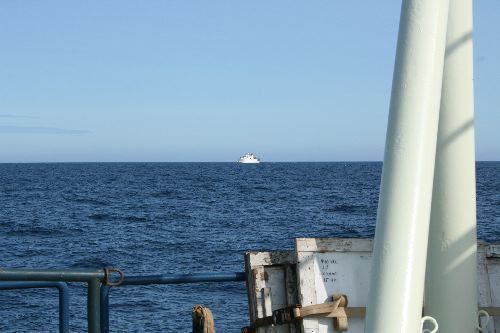Thursday, June 18, 2009
In the middle of this great big Bering Sea, who would have thought that we would meet up with another research vessel going to the same station at the same time as us? The NOAA ship R/V Oscar Dyson was in our area. This ship’s primary objective is to study and monitor Alaskan pollock and other fisheries in the Bering Sea and Gulf of Alaska. The ship also observes weather, sea state, and other environmental conditions, conducts habitat assessments, and surveys marine mammal and marine bird populations. It’s named after Oscar Dyson, an Alaskan fisheries leader and is homeported in Mr. Dyson's hometown of Kodiak, Alaska.

* **The Oscar Dyson passing close by*
Today we found out how a common marine organism can insert its presence and mess carefully planned experiments. The ship has a flow through seawater system, which allows the scientists to monitor the chemistry, and phytoplankton of the water the ship is sail through. We apparently met up with a large number of jellyfish that gummed up several of out instruments. The zooplankton scientists were having trouble with them getting into their plankton nets when they pulled them out of the water. So now it was my turn to experience their effect. Dr. Sambrotto, the missions Chief Scientist has several in instruments that rely on the flow through system and one of them, the one with the smallest tubing got chunks of sticky, gooey jellyfish parts in them. This required tearing down the instrument and cleaning out its tubing. Fortunately the seas were relatively calm and it time more then effort to rectify the situation. The Instrument is back up and collecting data on phytoplankton. Actually, it runs better then before. Its too bad I couldn’t get a picture of them. They apparently are down below the surface right where the ships seawater intake is. I will keep looking. By the time I am writing this however, I believe we have moved away from the "swarm”.
We have been cruising over the large shelf that takes up so much of the Bering Sea. We are getting close to the shelf break, which is where the shelf stops and deep water begins. This is known to be a very biologically active area. This is due to the upwelling of nutrients from the deep. The more nutrients the more phytoplankton, and hence more things that feed on phytoplankton, like zooplankton. And of course there are animals that live on the zooplankton, etc. I have already noticed an increase in the birds present, and I’m really looking forward to getting to this area of the Bering Sea. We should be there Friday morning.


Comments